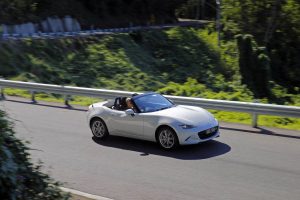Recalls: Mazda ND MX-5
Overview
Manufacturers, or importers, issue recalls for defects or faults which have the potential to cause injury. Generally, manufacturers will inform the original buyers if their vehicle is subject to a recall and of the steps required to remedy the defect or fault. Please note that the recalls below (if any) are for Australian-delivered vehicles only. Furthermore, the number of recalls should not be taken as an indication of a model’s reliability or its safety more generally.
Recalls: Mazda ND MX-5
2015-19 Mazda ND MX-5: automatic transmission downshift
In February 2019, recall campaign R201901 was issued for Mazda ND MX-5 vehicles that were available for sale in Australia from 20 July 2015 to 31 January 2019 and had automatic transmissions. In these vehicles, the Transmission Control Module (TCM) may incorrectly interpret an electrical signal from the gear selector – this could cause the automatic transmission to downshift unexpectedly, causing an abrupt wheel spin reduction. If this occurred, the stability of the vehicle may be affected and this increased the risk of injury for vehicle occupants and other road users. For the VINs of the recalled vehicles, please see PRA 2019/17325.
2015 Mazda ND MX-5: metal bracket for underbody cover could detach
In July 2019, recall campaign R201907 was issued for Mazda ND MX-5 vehicles that were available for sale in Australia from 27 May 2015 to 6 July 2014. In these vehicles, the metal bracket on the vehicle under cover could separate from the vehicle while it was being driven. The metal bracket may fall from the vehicle, increasing the risk of a collision or injury to vehicle occupants and other road users. For the VINs of the recalled vehicles, please see PRA 2019/17671.
2017-19 Mazda ND MX-5 vehicles: low pressure fuel pump could deform and cause stall
In December 2021, recall campaign R202104 was issued for 2017-19 Mazda ND MX-5 vehicles. The low pressure fuel pump impeller could become deformed and cause the fuel pump to stop working. This could cause the vehicle to stall and this loss of power while driving could increase the risk of a collision and injury to vehicle occupants and other road users. To fix, the low pressure fuel pump was to be replaced. For the VINs of the recalled vehicles, please see REC-005009.
Problems and faults: Mazda ND MX-5
Overview
This section identifies potential problems, causes and fixes based on the experiences of owners and repairers, online sources and technical service bulletins. This information is provided solely for reference purposes and AustralianCar.Reviews recommends that only properly qualified persons carry out repairs or modifications. Furthermore, the number of items below should not be taken as an indicator of a model’s reliability or the frequency with which they may occur.
To report a problem or fault to the AustralianCar.Reviews team, please use the Contact Us form. Note that AustralianCar.Reviews does not offer advice on automotive problems or disputes; such enquiries will not receive a reply. For vehicles purchased from dealers after 1 January 2011, please see our Australian Consumer Law fact sheet.
2015-16 Mazda ND MX-5 with manual transmission: damage to second and third gears
In October 2017, Mazda USA issued a technical service bulletin 05-001-17-3309c for 2016 and 2017 model year Mazda ND MX-5 vehicles that had manual transmissions; AustralianCar.Reviews understands that this corresponds to Mazda MX-5 vehicles manufactured prior to September 2017. According to the bulletin, these vehicles may exhibit the following symptoms:
- A grinding noise when the transmission was shifted from 1st to 2nd and/or from 2nd to 3rd gear or in the neutral position with the engine idling; and/or,
- It may be impossible to shift into 2nd and/or 3rd gear even though there was no problem shifting into other gears.
These symptoms were attributed to damage to the second and third gears that could be caused by rapid acceleration and deceleration that was accompanied by frequent shift changes. The ‘configuration’ of the second and third gears was subsequently changed – from serial number 6TJ0701679 – to increase their rigidity.
Mazda ND MX-5: clunking noise from rear suspension
In April 2017, Mazda issued a technical service bulletin for Mazda ND MX-5 vehicles because a clunking noise may be heard from the rear suspension when driving over road slopes or bumps. According to the service bulletin, this noise may be caused by the top two windings of the rear shock absorber coil spring interfering with one another and causing a stick-slip noise. To fix, a resin protector was to be fitted onto the coil spring.




